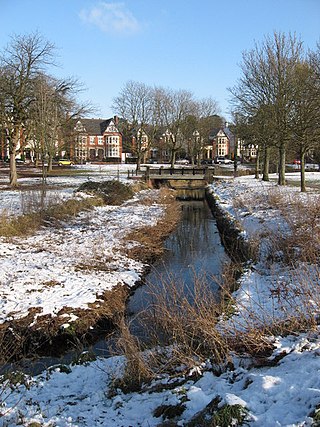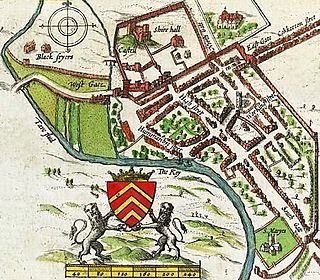
Roath is a district and community to the north-east of the city centre of Cardiff, capital of Wales. The area is mostly covered by the Plasnewydd electoral ward, and stretches from Adamsdown in the south to Roath Park in the north.

Whitchurch is a suburb and community in the north of Cardiff, capital of Wales. It is approximately 3 miles north of the centre of the city on the A470 road and A4054 road. It falls within the Whitchurch & Tongwynlais ward. The population of the community in 2011 was 14,267.
Cytûn: Churches Together in Wales is a national ecumenical organisation of churches in Wales, formed in 1990. It is the successor to the former Council of Churches for Wales. Cytûn's offices are located in Richmond Road, Cardiff.

St Padarn's Institute came into being in 2016. Until then the site belonged to St Michael's College, an Anglican theological college in Llandaff, Wales. St Michael's college was founded in Aberdare in 1892, and was situated in Llandaff from 1907 until 2016. Among its many alumni was the poet R. S. Thomas. The original building on the site was a house constructed for himself by John Prichard. After his death, that building was incorporated into the newly-founded St Michael's College, which was built mainly to the designs of F. R. Kempson between 1905-1907. In the late 1950s, a chapel was built by George Pace. The college had significant financial problems in the early 21st century and was eventually closed.

John Prichard was a Welsh architect in the neo-Gothic style. As diocesan architect of Llandaff, he was involved in the building or restoration of many churches in south Wales.
George Noakes was the Bishop of St Davids and the Archbishop of Wales.

Cardiff has many cultural sites varying from the historical Cardiff Castle and out of town Castell Coch to the more modern Wales Millennium Centre and Cardiff Bay. Cardiff was a finalist in the European Capital of Culture 2008.

St Mary Street and High Street are major commercial streets in the Castle Quarter of Cardiff city centre, Wales, which form a major thoroughfare running south from the gatehouse of Cardiff Castle. High Street begins at the junction of Castle Street on the A4161 and ends at the junction of Church Street and Quay Street, from where St Mary Street begins until the roundabout at Callaghan Square on the A4160.

Architecture in Cardiff, the capital city of Wales, dates from Norman times to the present day. Its urban fabric is largely Victorian and later, reflecting Cardiff's rise to prosperity as a major coal port in the 19th century. No single building style is associated with Cardiff, but the city centre retains several 19th and early 20th century shopping arcades.

St David's Welsh Church, Colwyn Bay is in Rhiw Road, Colwyn Bay, Conwy County Borough, Wales. It is an Anglican church in the parish of Colwyn Bay with Bryn-Y-Maen, the deanery of Rhos, the archdeaconry of St Asaph, and the diocese of St Asaph. The church is situated behind St Paul's Church and is a Grade II listed building.
John Coates Carter (1859–1927) was an English architect. Born in Norwich, Carter is notable for his design and restoration to churches in South Wales, and in particular Glamorgan. He was partnered with John Pollard Seddon from 1884 to 1904 and after he maintained a style steeped in the traditions of the Arts and Crafts Movement to create impressive buildings such as the monastery on Caldey Island and St Luke's Church in Abercarn.

St Mary's Church was an Anglican church in Cardiff, Wales, which stood at the south end of the current St. Mary's Street, from 1107 until 1620. After severe flood damage it was abandoned in 1701 and later replaced at a different location in 1843.

There are around 1,000 listed buildings in Cardiff, the capital city of Wales. A listed building is one considered to be of special architectural, historical or cultural significance, which is protected from being demolished, extended or altered, unless special permission is granted by the relevant planning authorities. The Welsh Government makes decisions on individual cases, taking advice from the heritage agency Cadw, the Royal Commission on the Ancient and Historical Monuments of Wales and local councils.

St German's Church is a nineteenth-century Church in Wales parish church in Adamsdown, Cardiff, Wales dedicated to St Germanus of Auxerre,. The building, located on the corner of Star Street and Metal Street, is a Grade I Listed building.

St James the Great is a church located opposite the Cardiff Royal Infirmary on Newport Road, near the centre of Cardiff, Wales. It closed in 2006 after 112 years as an Anglican place of worship.

Alexander Roos was an Italian-born British architect and urban planner. He was the architect to the Bute Estates in South Wales, for which he designed many buildings and laid out several areas of Cardiff.

Eglwys Dewi Sant or St David's Church, was an Anglican parish church in the town of Carmarthen, Carmarthenshire, Wales. Built in the 1830s and briefly considered as a possible replacement cathedral for the dioceses of St David's, the church eventually became the home of Carmarthen's main Welsh-speaking Anglican congregation. The church closed in the early twenty-first century after the building became unsafe.

St Mary's Church, Aberavon, is an Anglican church in Port Talbot, UK. It is part of the Rectorial Benefice of Aberavon. It has been a Grade II listed building since 31 January 2000.
St David's, Cardiff is a shopping centre in Cardiff city centre.
















